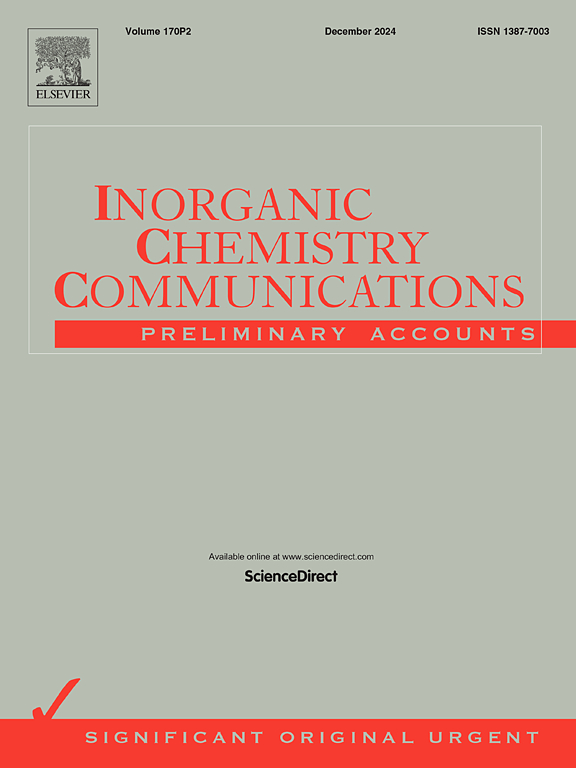Fc-DNP/PVDF nanofiber matrix for selective visual detection of cyanide ion (CN−) from tobacco, food, and water samples via a ratiometric process
IF 4.4
3区 化学
Q1 CHEMISTRY, INORGANIC & NUCLEAR
引用次数: 0
Abstract
A highly selective detection of cyanide ion (CN−) in multiple way has been achieved by Fc-DNP, an azomethine functionalized ferrocene clutched compound. The synthesized probe has been systematically characterized and the final confirmation was obtained through SC-XRD. Fc-DNP crystallises in a monoclinic crystal system with a P-1, 21/C1 centrosymmetric space group. The probe has shown excellent photophysical properties, and aggregation induced emission (AIE) property makes it an appropriate material for real-time application. The synthethised probe Fc-DNP has been incorporated with PVDF matrix via electrospinning technique to obtain Fc-DNP/PVDF nano fibre matrix. Henceforth, Fc-BPy has been deployed for the selective detection of CN− in multiple methods, including naked eye colorimetric, fluorimetric and solid-state detection. The probe demonstrates a substantial color change upon introduction of CN− from pale yellow to wine with significant shift in absorbance of the Fc-DNP probe from 393 nm to 501 nm distincitve indication of ratiometric detection of cyanide ion. The detection efficacy of the probe were also in solid state matrix, which exhibited commendable limit of detection (LOD) 4.90 × 10−10 M. The detection mechanism and stoichiometric ratio were validated through NMR titration, Jobs plot and DFT studies. Furthermore, the practical applicatbility of the probe Fc-DNP was evaluated from commercial tobacco sample, food and water samples. The recovery rate was quite astounding with the relative standard deviation (RSD) ≤1.15 %, ≤1.21 % and ≤1.33 % based on triplicate measurements. Thus, Fc-DNP emerges as a cost-effective, simple probe for CN− detection across different analytical techniques.
Fc-DNP/PVDF纳米纤维基质通过比例法选择性视觉检测烟草、食品和水样中的氰化物离子(CN -)
采用亚胺功能化的二茂铁螯合物Fc-DNP,实现了对氰化物离子(CN−)的多途径高选择性检测。对合成的探针进行了系统表征,并通过SC-XRD得到了最终的证实。Fc-DNP在p - 1,21 /C1中心对称空间群的单斜晶系中结晶。该探针表现出优异的光物理性能,其聚集诱导发射特性使其成为实时应用的合适材料。将合成的探针Fc-DNP通过静电纺丝技术与PVDF基体结合,得到Fc-DNP/PVDF纳米纤维基体。此后,Fc-BPy已被用于多种方法的CN -选择性检测,包括肉眼比色法、荧光法和固态检测。在引入CN -后,探针的颜色发生了实质性的变化,从淡黄色到葡萄酒,Fc-DNP探针的吸光度从393 nm显著变化到501 nm,这是氰化物离子比例检测的明显标志。该探针在固体基质中的检测效果良好,检出限(LOD)为4.90 × 10−10 m,通过NMR滴定、Jobs图和DFT研究验证了其检测机理和化学计量比。此外,还从商业烟草样品、食品样品和水样中评估了探针Fc-DNP的实际应用。三次测量的相对标准偏差(RSD)分别≤1.15%、≤1.21%和≤1.33%,回收率相当高。因此,Fc-DNP作为一种具有成本效益的,简单的探针,可用于不同分析技术的CN -检测。
本文章由计算机程序翻译,如有差异,请以英文原文为准。
求助全文
约1分钟内获得全文
求助全文
来源期刊

Inorganic Chemistry Communications
化学-无机化学与核化学
CiteScore
5.50
自引率
7.90%
发文量
1013
审稿时长
53 days
期刊介绍:
Launched in January 1998, Inorganic Chemistry Communications is an international journal dedicated to the rapid publication of short communications in the major areas of inorganic, organometallic and supramolecular chemistry. Topics include synthetic and reaction chemistry, kinetics and mechanisms of reactions, bioinorganic chemistry, photochemistry and the use of metal and organometallic compounds in stoichiometric and catalytic synthesis or organic compounds.
 求助内容:
求助内容: 应助结果提醒方式:
应助结果提醒方式:


